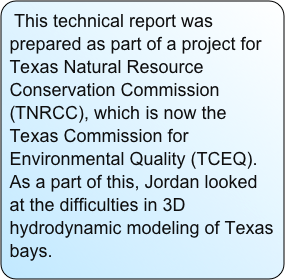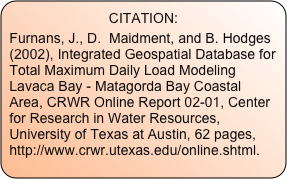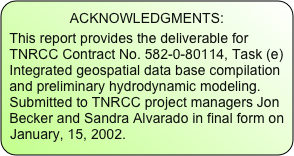An Integrated Geospatial Database for Total Maximum Daily Load Modeling of the Lavaca Bay - Matagorda Bay Coastal Area
Jordan Furnans, David Maidment and Ben Hodges
Abstract
Lavaca Bay is a micro-tidal estuary located along the Texas Gulf Coast near Point Comfort, TX and Port Lavaca, TX. It is a secondary bay that exchanges flow with Matagorda Bay, which in turn exchanges flow with the Gulf of Mexico. The bay is currently listed on the Texas 303(d) list for mercury contamination, low dissolved oxygen, and pathogens. In order to remediate the Bay, the Texas Natural Resource Conservation Commission (TNRCC) must develop and implement a Total Maximum Daily Load (TMDL) for each of these three pollution problems. The TMDL development process often involves sampling and watershed/waterbody modeling, and is highly dependent upon the pollutants and the area involved. For example, the main source of mercury contamination within Lavaca Bay is suspected to be derived from the “Dredge Island” created by the ALCOA Alumina & Chemicals facility in Point Comfort. The TMDL modeling for mercury must address the potential contaminant movement from that source location, and therefore must involve hydrodynamic modeling. TMDL modeling for dissolved oxygen must be of a different form, because the main source of the hypoxia is likely to be non-point source pollution. Therefore, the TMDL process for dissolved oxygen must be more dependent upon watershed and runoff modeling. This report describes data and modeling techniques that are applicable to TMDL development for Lavaca Bay.











